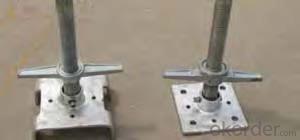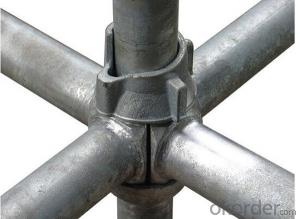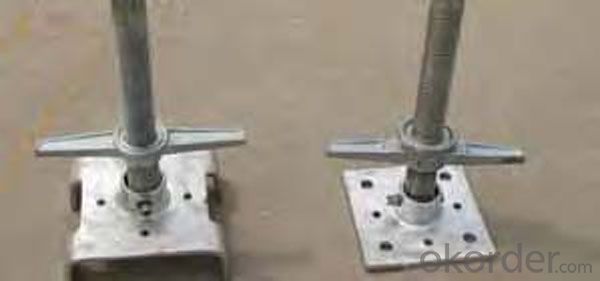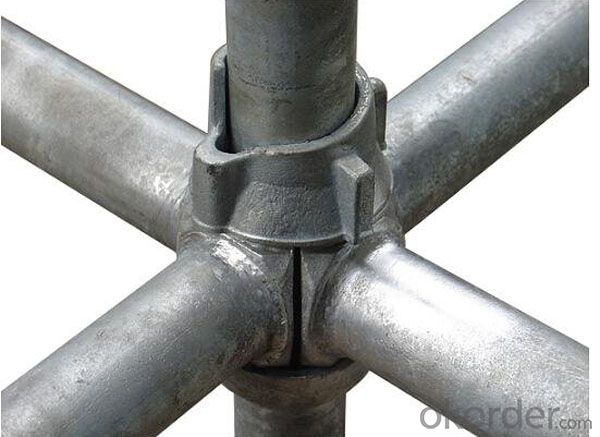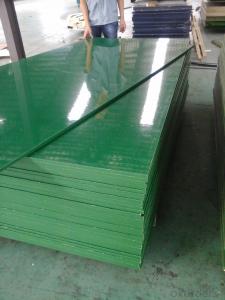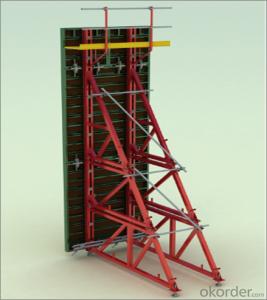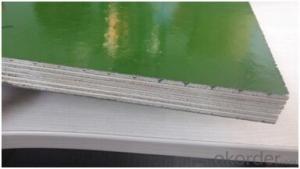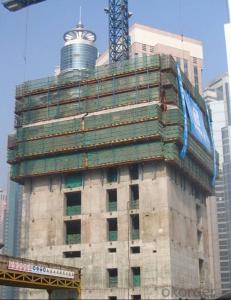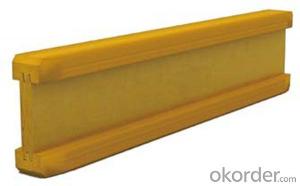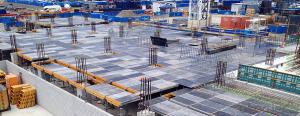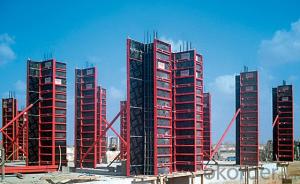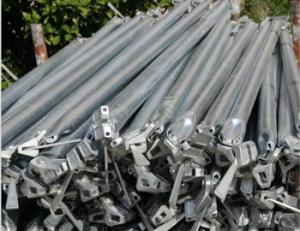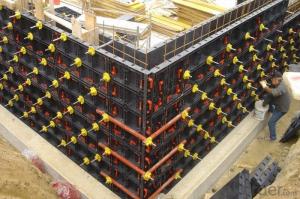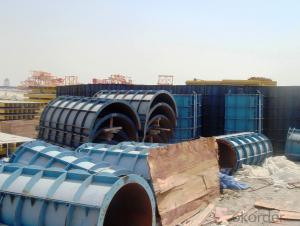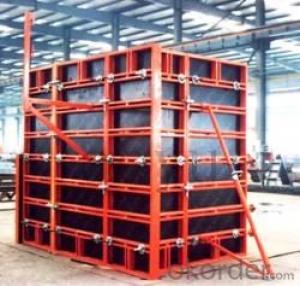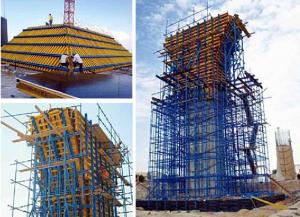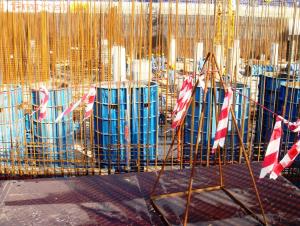Circular Column Formwork Outrigger For Scaffolding With New Design
- Loading Port:
- Tianjin
- Payment Terms:
- TT OR LC
- Min Order Qty:
- 20000 set
- Supply Capability:
- 50000 set/month
OKorder Service Pledge
OKorder Financial Service
You Might Also Like
Circular Column Formwork Outrigger For Scaffolding With New Design
Plastic Formwork Concrete Formwork Circular Column Used Scaffolding Props New Design
Developing with new technology materials, steel formworks is no longer a must in construction concrete process. More and more buildings are established with plastic formworks. And workers love this new formworks much more.
The advantages of plastic formworks:
1.First of all--light
Yes it is the first advantage of plastic formwork. It wins the great praise of both contractors and workers.
The biggest panel is 120×1500px,weights 10.5kg only. It can be lift and set up by one person easily, which means there is no need for cranes on site.Saves a lot of cost and time.
2.Easy set up
Different size of panels can firmly locked by simply turn the special handles to 90 degree. The Panels has rib on the back, which makes the system need not traditional wood blocks and nails. The panels have holes to fit tie rod, guarantee the strength of the whole system.
3.Modularity
Modular formworks composed by different size of panels..
4.Strength
The handles are made by high strength Nilon, each panel locked by at least 4 handles, which makes the whole system strong enough to pour 1000px walls.
5.Environment friendly
The system needs no cut and nail due to the variety size. Also it needs nearly no wood. The material can be recycled after broken, so it will not pollute the environment.
6.Consequent
Concrete does not stick to plastic formwork, thus the panels need no oil before using, and can be cleaned simply by water. The surface of the wall which build by modular formwork is smooth and without rework.
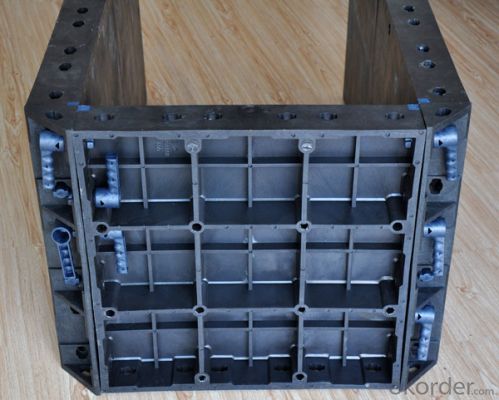
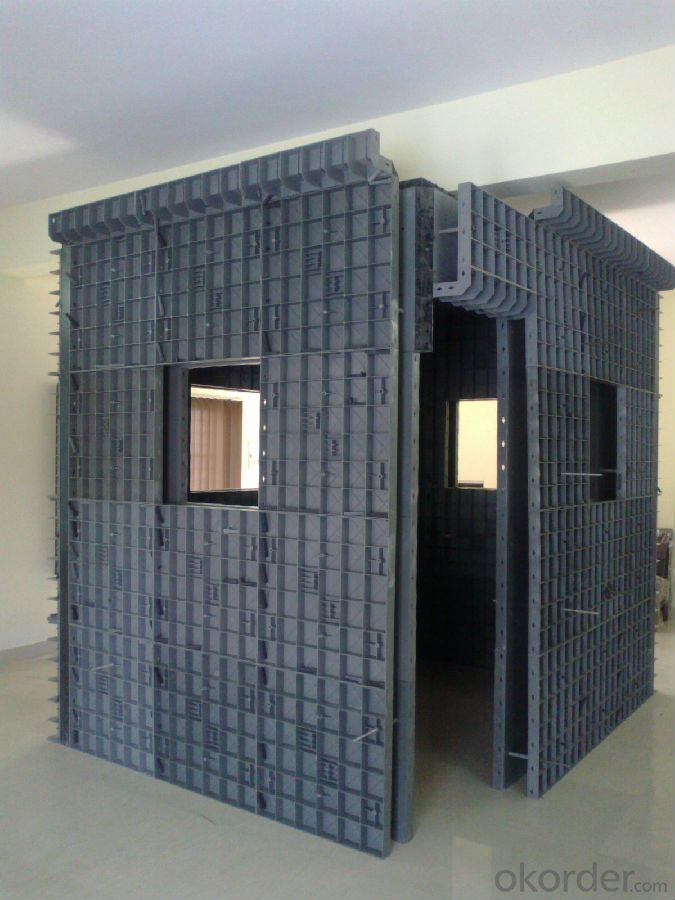
Advantage
* Good loading capacity
* Easy to assemble and dismantle
* Stable and durable thanks to its structual design & automatic welding quality
* Customized solution helps you work safe, save cost and convenient
* Excellent quality for formwork & scaffolding with wide choices
Packing
in bulk or in bundle, or as requested
Shipping
15-20 Days.
Normally small orders, it needs just 15-20 business days to the port. For goods with stock, it would be even shoter.
Other scaffolding & formwork products:
(1) Scaffolding System:
Including Ringlock Scaffolding System and accessories; Cuplock Scaffolding System and accessories; Kwikstage Scaffolding System and accessories; Haki Scaffolding System and accessories;
(2) Scaffolding Frame & Accessories:
Including Walk Through Frame Scaffolding; Ladder Frame Scaffolding; Accessories; we also can make scaffolding according to your samples or drawings.
(3) Scaffolding Couplers/Clamps:
We can produce all kinds of forged and pressed couplers, including British type couplers, American type couplers, German type couplers, Italian type couplers ,fence couplers, BRC coplers and so on. We also can produce according to your drawings or samples.
FAQ
Why Us?
We are one of the Top 500 in the world, largest construction materials supplier in China. Also we are a state-owned company and respond to every customer with large and also small orders.
We own professional manufacturers with powerful producing capacity.
Extensive and comprehensive quality control system
Excellent products with competitive prices.
Efficient services in pre and after sale.
Full energy with affluent experience team.
- Q: How does steel frame formwork ensure proper curing of concrete?
- Steel frame formwork ensures proper curing of concrete in several ways. Firstly, the steel frame provides a strong and rigid structure that holds the concrete in place during the curing process. This prevents any movement or deformation of the concrete, allowing it to set and harden properly. Secondly, steel frame formwork is designed with various features that promote proper curing. These features include built-in water channels and drainage systems that allow for the controlled and efficient removal of excess water from the concrete. This helps to prevent the formation of voids or weak spots in the cured concrete. Additionally, the steel frame formwork can be easily insulated to maintain a consistent temperature during the curing process. This is important as temperature fluctuations can negatively affect the strength and durability of the concrete. By providing insulation, the steel frame formwork helps to create ideal curing conditions and ensures that the concrete cures uniformly. Furthermore, steel frame formwork allows for easy access to the concrete surface, which is essential for proper curing. It enables workers to monitor the curing process, perform necessary inspections, and make any adjustments if needed. This ensures that the concrete is curing correctly and allows for any issues to be addressed promptly. Overall, the use of steel frame formwork in concrete construction plays a crucial role in ensuring proper curing. It provides a stable and secure structure, facilitates efficient water removal, allows for temperature control, and enables easy access for monitoring and inspection. These factors combined contribute to the production of high-quality and durable concrete structures.
- Q: Can steel frame formwork be used for educational buildings?
- Yes, steel frame formwork can be used for educational buildings. It provides a sturdy and durable structure, ensuring the safety and longevity of the building. Additionally, steel frame formwork allows for flexibility in design and construction, accommodating various architectural and educational requirements.
- Q: What are the common safety precautions for using steel frame formwork systems in high-rise construction?
- When using steel frame formwork systems in high-rise construction, there are several common safety precautions that should be followed to ensure the safety of workers and the success of the project. These precautions include: 1. Adequate training: All workers involved in the assembly, disassembly, and use of steel frame formwork systems should receive proper training on their safe handling and operation. This includes understanding the specific procedures and precautions related to the system being used. 2. Inspection and maintenance: Regular inspection and maintenance of the steel frame formwork systems are crucial to identify any defects or damage that could compromise safety. All components should be checked for signs of wear, deformation, or corrosion, and any issues should be addressed promptly. 3. Proper installation: It is essential to follow the manufacturer's instructions for the correct installation of the steel frame formwork system. This includes ensuring that all components are securely connected and that the system is stable and rigid. Any deviation from the installation guidelines can lead to structural instability and increase the risk of accidents. 4. Secure anchoring: Steel frame formwork systems should be properly anchored to the building structure to prevent movement or collapse during concrete pouring or other construction activities. Adequate bracing and tie-backs should be used to ensure stability and prevent any potential hazards. 5. Load capacity: It is crucial to be aware of the maximum load capacity of the steel frame formwork system and ensure that it is not exceeded. Overloading can lead to structural failure and pose a significant safety risk to workers. 6. Fall protection: High-rise construction involves working at heights, so it is essential to provide adequate fall protection measures. This can include the use of guardrails, safety harnesses, and safety nets to prevent falls and protect workers from injuries. 7. Regular inspections during use: While the formwork system is in use, regular inspections should be conducted to ensure its stability and integrity. Any signs of damage or movement should be addressed immediately to prevent accidents. 8. Communication and coordination: Effective communication and coordination among all workers involved in the installation and use of the steel frame formwork system are paramount. Clear communication ensures that everyone understands their roles and responsibilities, minimizing the risk of accidents caused by miscommunication or confusion. By following these common safety precautions, the use of steel frame formwork systems in high-rise construction can be done with a reduced risk of accidents and injuries, ensuring the safety of the workers and the successful completion of the project.
- Q: What are the different types of shoring systems used with steel frame formwork?
- There are several types of shoring systems that can be used with steel frame formwork. These systems are designed to provide support and stability to the formwork structure during the construction process. 1. Adjustable Steel Props: This is one of the most commonly used shoring systems. Adjustable steel props consist of a steel tube with an adjustable mechanism that allows for the height to be easily adjusted. These props are placed vertically between the formwork and the ground, providing support and load-bearing capacity. 2. Cuplock System: The cuplock system is a modular shoring system that uses a unique cup and blade locking mechanism to secure horizontal and vertical members together. This system is quick and easy to assemble and provides excellent load-bearing capacity. It can be used for both vertical and horizontal shoring applications. 3. Kwikstage System: The Kwikstage system is another modular shoring system that uses a combination of vertical and horizontal components. The vertical components consist of standards and ledgers, which are connected using wedge connectors. This system is versatile and can be used for a wide range of shoring applications. 4. Frame Shoring Systems: Frame shoring systems consist of steel frames that are placed vertically and horizontally to provide support to the formwork structure. These frames are connected using pins or bolts, and the height can be adjusted as needed. Frame shoring systems are easy to assemble and can be used for various shoring requirements. 5. Flying Shoring Systems: Flying shoring systems are used when there is a need to move the formwork structure horizontally during the construction process. These systems consist of steel trusses or beams that are supported by vertical props. The horizontal movement is achieved by using hydraulic jacks or other lifting mechanisms. Overall, the choice of shoring system depends on the specific requirements of the construction project, such as the height and weight of the formwork structure, the desired level of adjustability, and the need for horizontal movement. Professional engineers and contractors can assess the project needs and select the most suitable shoring system for steel frame formwork.
- Q: Are there any environmental considerations associated with steel frame formwork?
- Yes, there are several environmental considerations associated with steel frame formwork. Firstly, the production of steel involves high energy consumption and carbon emissions, contributing to climate change. Additionally, steel is a non-renewable resource, and its extraction can lead to habitat destruction and water pollution. Furthermore, steel formwork requires regular maintenance and may generate waste during construction and demolition. Therefore, it is important to assess the environmental impact and explore sustainable alternatives when using steel frame formwork.
- Q: Are there any specific design considerations when using steel frame formwork?
- Yes, there are several specific design considerations when using steel frame formwork in construction projects. Firstly, the strength and stability of the steel frame formwork system need to be carefully assessed and designed to ensure that it can withstand the loads imposed during concrete pouring and curing. This includes considering factors such as the weight of the concrete, wind loads, and any additional loads from construction equipment or workers. Secondly, the dimensions and layout of the steel frame formwork should be designed to accommodate the desired shape and size of the concrete structure. This may involve incorporating adjustable panels or modular components to allow for flexibility and ease of assembly. Thirdly, the connections between the steel frame formwork components need to be carefully designed to ensure proper alignment and stability. This may include using high-quality fasteners and ensuring that the connections are adequately braced to prevent any movement or deformation during the concrete pouring process. Additionally, considerations should be given to the surface finish requirements of the concrete structure. Steel frame formwork may leave imprints or marks on the concrete surface, so appropriate measures should be taken to minimize any undesirable effects, such as using plywood or plastic lining on the contact surfaces. Lastly, safety is a crucial consideration when using steel frame formwork. The design should incorporate appropriate safety features, such as guardrails, handrails, and access platforms, to ensure the safety of workers during the construction process. Overall, the design of steel frame formwork should take into account structural strength, dimensional requirements, connections, surface finish, and safety to ensure a successful and efficient construction process.
- Q: How does steel frame formwork handle the placement of concrete in overhead structures or ceilings?
- Steel frame formwork is a versatile and efficient system for handling the placement of concrete in overhead structures or ceilings. This method of formwork offers multiple advantages, making it suitable for various construction projects. Firstly, the steel frame formwork provides excellent strength and durability, ensuring the safe and reliable support of the concrete during the pouring process. Its robust structure can withstand the weight of the wet concrete, preventing any collapse or deformation that could compromise the integrity of the overhead structure or ceiling. Furthermore, steel frame formwork is designed with adjustable components, allowing for flexibility in adapting to different shapes and sizes of overhead structures or ceilings. The modular nature of the system enables easy customization and quick assembly, saving time and resources during the construction process. In addition, steel frame formwork is highly reusable, making it a cost-effective solution for multiple projects. The steel frames can be disassembled and reassembled easily, reducing the need for additional formwork materials and reducing waste. This not only saves money but also contributes to sustainable construction practices. Moreover, the steel frame formwork provides a smooth and even surface finish to the concrete, ensuring a high-quality end result. The precise alignment and tight joints of the steel frames help eliminate any potential defects or imperfections, resulting in a visually appealing and structurally sound overhead structure or ceiling. Overall, steel frame formwork is a reliable and efficient method for handling the placement of concrete in overhead structures or ceilings. Its strength, flexibility, reusability, and ability to provide a smooth finish make it an ideal choice for construction projects where safety, efficiency, and quality are paramount.
- Q: How does steel frame formwork help in reducing concrete wastage?
- Steel frame formwork helps in reducing concrete wastage by providing a strong and sturdy structure to hold the concrete in place during the pouring and curing process. This formwork system consists of steel frames that are easily assembled and disassembled, allowing for efficient and repeated use. One of the key advantages of steel frame formwork is its ability to accurately shape and support the concrete, ensuring that it is poured in the desired shape and dimensions. This precision minimizes the need for excessive concrete usage, reducing wastage. Furthermore, the steel frame formwork is designed to be highly durable and resistant to wear and tear. This longevity allows for multiple uses, reducing the need for constant replacement and minimizing waste generation. Additionally, steel frame formwork offers adjustable features that allow for customization and flexibility in concrete placement. This adaptability ensures that the formwork can be easily adjusted to accommodate different shapes and sizes, reducing the risk of errors and concrete wastage. Overall, the use of steel frame formwork in construction projects helps optimize the use of concrete, reducing wastage and promoting sustainability. Its strength, durability, and flexibility contribute to a more efficient and eco-friendly construction process.
- Q: Can steel frame formwork be used for retrofitting or renovation projects?
- Retrofitting or renovation projects can effectively utilize steel frame formwork. This versatile and durable system is commonly employed in various construction projects, including retrofitting and renovation endeavors. Designed to offer support and structure during the concrete pouring and curing process, steel frame formwork proves beneficial. In retrofitting or renovation projects, steel frame formwork serves multiple purposes. It can create new concrete structures or reinforce and repair existing ones. Whether it involves constructing walls, beams, columns, slabs, or reinforcing pre-existing elements, steel frame formwork can handle the task. One advantage of utilizing steel frame formwork in retrofitting projects is its ability to provide a sturdy and stable support system, ensuring proper pouring and curing of concrete. Moreover, it can be easily adjusted and repositioned to accommodate design and construction flexibility. Another benefit of steel frame formwork is its reusability, making it a cost-effective and environmentally friendly option. It can be effortlessly dismantled and utilized in multiple projects, reducing waste and conserving resources. In conclusion, steel frame formwork is an efficient and fitting solution for retrofitting or renovation projects. It offers the necessary support and structure for concrete elements while providing flexibility, durability, and cost-effectiveness.
- Q: How does steel frame formwork handle different concrete mix designs?
- Steel frame formwork is designed to handle different concrete mix designs by providing a strong and rigid structure that can withstand the pressure and weight of various concrete compositions. The steel frame is versatile enough to accommodate changes in the concrete mix design, ensuring proper support and stability during the pouring and curing process. Additionally, the steel formwork can be easily adjusted and modified to meet the specific requirements of each mix design, allowing for efficient construction and optimal results.
Send your message to us
Circular Column Formwork Outrigger For Scaffolding With New Design
- Loading Port:
- Tianjin
- Payment Terms:
- TT OR LC
- Min Order Qty:
- 20000 set
- Supply Capability:
- 50000 set/month
OKorder Service Pledge
OKorder Financial Service
Similar products
Hot products
Hot Searches
Related keywords
